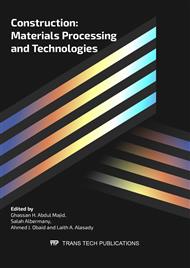p.11
p.21
p.29
p.39
p.49
p.61
p.73
p.81
p.97
Strengthening of Composite Castellated Beams Web with Corrugated Carbon Fiber Reinforced Polymer Struts
Abstract:
A total of seven simply supported composite specimens are tested under concentrated load at the mid-span of the beam to investigate the strength of specimens to resist the applied load if web buckling take place. A novel technique of using a corrugated CFRP struts to strengthen the web of the steel girder is presented in this study. This technique provides two layers of CFRP laminate which are from biaxial fabrics to provide a knitted material that can undergo the complex state of stress in the web. The studied specimens are divided into two groups in addition to the control specimen having the same length. There are three specimens in each group, these specimens have different castellation ratios of (33.3%, 43.3% and 54.3%), the first group is identical to the second one except that the second group was strengthened with the proposed CFRP corrugated struts while the first one kept unstrengthen as a reference. Composite beams have a vertical stiffener at the action area above the supports. The reference group showed decrease in deflection of (11.11, 20 and 26.67) % for (33.3, 43.3 and 54.3) castellation ratio while strengthened girders record (13.75, 6.11 and 13.93) % for the same opening depths, compared to the control specimen. In addition, CFRP struts decrease the web buckling from (1.6, 2.9 and 83.33) to (0.8, 0.4 and 0.3) mm for beams with castellation ratio of (33.3, 43.3 and 54.3) respectively.
Info:
Periodical:
Pages:
49-60
Citation:
Online since:
October 2020
Authors:
Price:
Сopyright:
© 2020 Trans Tech Publications Ltd. All Rights Reserved
Share:
Citation:


